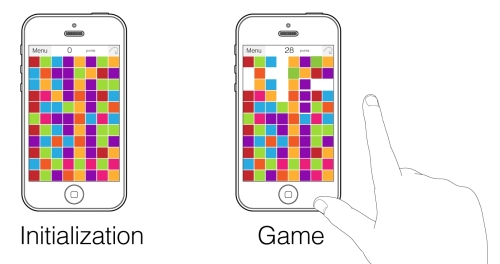Puzzle development should be started with the most obvious and easy-to-develop game mechanics, I'm talking about a simple match-three game with a passive array. Let's call it Static. The artwork will feature the flat look that is currently in fashion; instead of complicated images, simple color squares are used as main tiles. They look stylish (as you can see in the following screenshot) and they facilitate the debugging process:

Tiles cover all of the screen with the exception of the very top part, where a status bar is situated, displaying the Menu and Undo buttons and the scoring values. The width of the tile is 40 points, so there are eight items in a row and eleven in a column; the dimensions of the array are 8 x 11 elements for the iPhone 4 and about 8 x 13 for the iPhone 5 (for the iPad, the dimensions can be changed). Also worth noting is that these dimensions should be adjustable and depend on the difficulty level of the game. Easy mode may utilize smaller arrays, consisting of 4 x 6 elements, for example. The background is white because this can increase the attractiveness of color tiles and make them look brighter and pure.
A basic part of the game engine is a roll call function to count all the tiles, which are connected without gaps. It returns a number of such elements, and then this value is converted into points. It marks each tile that was included in the sequence, outlining a special zone in the array.
In Static mode, the function is activated when a player taps the screen. This gives it the coordinates of a tile in the array to start with. When the outlined zone of tiles is determined and the score is already calculated, the next phase begins.
The game removes the marked tiles and empty spaces and fills them out with the tiles found above, giving the impression that they "fall down". If the array's column becomes totally empty, its place is taken by the column standing next to it. All through the game, the content of the array becomes progressively smaller; it shrinks and moves to the bottom-left corner of the game board.
The trigger to finish the game is a lack of any new tile sequences. In other words, only single and unconnected elements remain and it is simply impossible to play further. The final score can be now added to the leaderboard; it is very important to show the player a list of points he got because the challenge is to earn more points than before.
As you can see, such a prototype is quite simple and can be developed during one evening, by the end of which it looks and operates like a fully functional game. Only the sky is the limit, let's move on and make the game more complex by adding some new elements.
